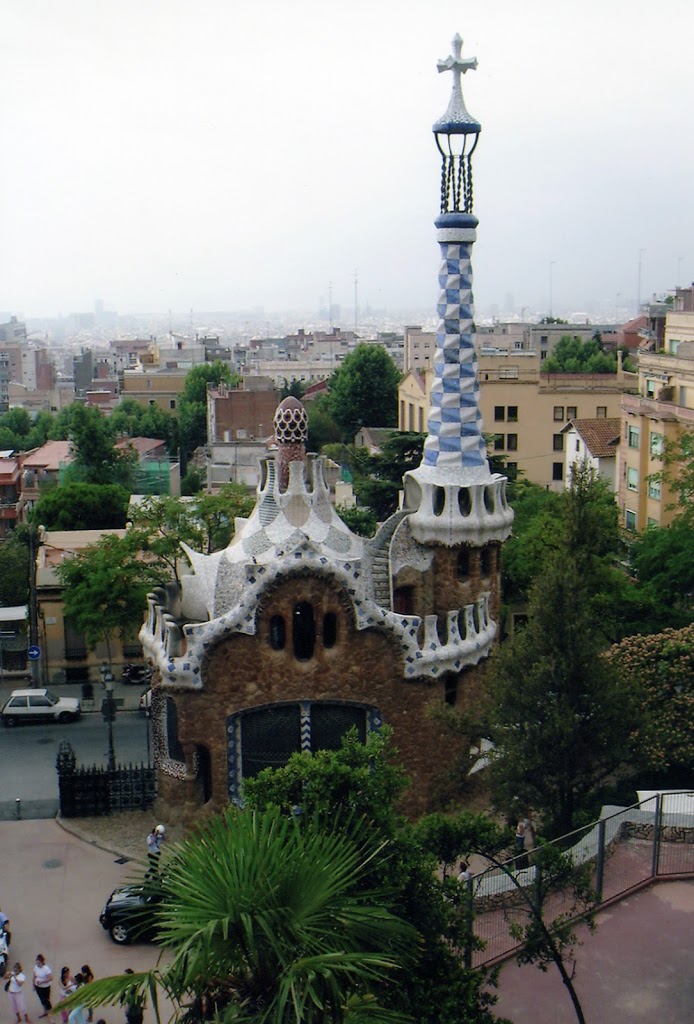The rich and fertile imagination of Catalan architect Antoni Gaudí (1852-1926) is seen all over the city of Barcelona. Gaudí was a part of Modernista in Barcelona, a Romantic design movement related to Art Nouveau His curved lines and organic shapes were probably inspirations to the Surrealist painters from Catalonia, Joan Miró and Salvador Dalí.
Two homes at the entry to Parc Güell are sometimes described as Hansel and Gretl Houses
 Gaudí designed a expansive public park in Barcelona, Parc Güell, originally to be like English gardens and to include a housing development which did not sell. His curves and points are a delight to explore, as I did in a visit several years ago. The colorful lizard tiles adorning a huge staircase doubles as a fountain. There are several pavilions, gates, curving walls and benches. The Gaudí House Museum, where the architect once lived,
Gaudí designed a expansive public park in Barcelona, Parc Güell, originally to be like English gardens and to include a housing development which did not sell. His curves and points are a delight to explore, as I did in a visit several years ago. The colorful lizard tiles adorning a huge staircase doubles as a fountain. There are several pavilions, gates, curving walls and benches. The Gaudí House Museum, where the architect once lived,is also in this park.
 Gaudí worked consistently on La Sagrada Familia from 1883 until his death, even living in a room within the building. It has been taking more than 130 years to build and is expected to be completed by by 2026–a hundred years after his death. When I was there 7 years ago, much of the exterior shell was done. In the end, it will have 18 towers and will rise 568 feet (170 meters) high. Its style combines the Gothic style with curvilinear Art Nouveau forms.
Gaudí worked consistently on La Sagrada Familia from 1883 until his death, even living in a room within the building. It has been taking more than 130 years to build and is expected to be completed by by 2026–a hundred years after his death. When I was there 7 years ago, much of the exterior shell was done. In the end, it will have 18 towers and will rise 568 feet (170 meters) high. Its style combines the Gothic style with curvilinear Art Nouveau forms. Gaudí was not only a great sculptural designer, but he was a genius of mathematical calculations. He designed pointed arches for the Sagrada Familia, as in the Gothic style, but he figured out how to do it without the need for buttresses. A modern computer program was able to determine that Gaudí arches are in the shape of parabolas.
Gaudí was not only a great sculptural designer, but he was a genius of mathematical calculations. He designed pointed arches for the Sagrada Familia, as in the Gothic style, but he figured out how to do it without the need for buttresses. A modern computer program was able to determine that Gaudí arches are in the shape of parabolas. 
Whimsical faces, left, are vent covers pointing into the sky from the roof Casa Milà in Barcelona, perhaps Gaudí’s most famous apartment building, left.
Gaudi’s animation continues in another apartment building, Casa Batlló, below, where the balconies form masks……..Casa Batlló has a rich surface of tiles, multicolored on the facade, but shaped like the scales of a dragon on the roof. Next door is Casa Amatller, by modernista architect Puig i Cadafalch.
When lit at night, Casa Batlló’s roof forms the body of a dragon, while a cross-shaped tower suggests the triumph of St. George over the dragon, or a victory of the cross over death and sin.







Recent Comments